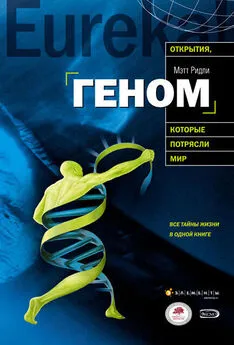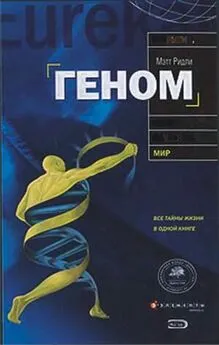Мэтт Ридли - Геном: автобиография вида в 23 главах
- Название:Геном: автобиография вида в 23 главах
- Автор:
- Жанр:
- Издательство:Эксмо
- Год:2008
- Город:Москва
- ISBN:978-5-699-30682-4
- Рейтинг:
- Избранное:Добавить в избранное
-
Отзывы:
-
Ваша оценка:
Мэтт Ридли - Геном: автобиография вида в 23 главах краткое содержание
Генетика развивается столь стремительно, что уследить за тем, как изменяются наши представления о фундаментальных основах жизни и наследственности, не успевает не только широкая публика, но и специалисты. Это порождает массу слухов и домыслов о страшных мутантах, которых коварные ученые штампуют в своих лабораториях, тогда как поразительные открытия новых методов диагностики и лечения генетических заболеваний, включая рак, остаются незамеченными или непонятыми. Книга Мэтта Ридли очень актуальна. Просто и доступно автор представил историю генетики от первых догадок до ошеломляющего прорыва, начавшегося с открытия структуры ДНК Уотсоном и Криком.
На английском языке книга вышла в свет в конце 1999 года, в канун нового тысячелетия. Но эта книга по-прежнему занимает топовые позиции в рейтингах продаж по всему миру. В ней есть то, что не устаревает: дух научных открытий и история генетики, представленная со всем драматизмом споров, дискуссий, озарений одних ученых и черной завистью других.
Геном: автобиография вида в 23 главах - читать онлайн бесплатно ознакомительный отрывок
Интервал:
Закладка:
Holden C., Mace R. 1997. Phylogenetic analysis of the evolution of lactose digestion in adults. Human Biology 69: 605–628.
131
Slagboom P. E., Droog S., Boomsma D. I. 1994. Genetic determination of telomere size in humans: a twin study of three age groups. American Journal of Human Genetics 55: 876–882.
132
Lingner J. et al. 1997. Reverse transcriptase motifs in the catalytic subunit of telomerase. Science 276: 561–567.
133
Clark M. S., Wall W. J. 1996. Chromosomes: the complex code . Chapman and Hall, London.
134
Harrington L. et al. 1997. A mammalian telomerase-associated protein. Science 275: 973–977;
Saito T. et al. 1997. Comparative gene-mapping of the human and mouse TEP1 genes, which encode one protein component of telomerases. Genomics 46: 46–50.
135
Bodnar A. G. et al. 1998. Extension of life-span by introduction of telomerase into normal human cells. Science 279: 349–352.
136
Niida H. et al. 1998. Severe growth defect in mouse cells lacking the telomerase RNA component. Nature Genetics 19: 203–206.
137
Chang E., Harley C. B. 1995. Telomere length and replicative aging in human vascular tissues. Proceedings of the National Academy of Science of the USA 92: 11190–11194.
138
Austad S. 1997. Why we age . John Wiley, New York.
139
Slagboom P. E., Droog S., Boomsma D. I. 1994. Genetic determination of telomere size in humans: a twin study of three age groups. American Journal of Human Genetics 55: 876–882.
140
Ivanova R. et al. 1998. HLA-DR alleles display sex-dependent effects on survival and discriminate between individual and familiar longevity. Human Molecular Genetics 7: 187–194.
141
Austad S. 1997. Why we age . John Wiley, New York.
142
Feng J. et al. 1995. The RNA component of human telomerase. Science 269: 1236–1241.
143
Holm V. et al. 1993. Prader-Willi syndrome: consensus diagnostic criteria. Pediatrics 91: 398–401.
144
Angelman H. 1965. ‘Puppet’ children. Developmental Medicine and Child Neurology 7: 681–688.
145
McGrath J., Solter D. 1984. Completion of mouse embryogenesis requires both the maternal and paternal genomes. Cell 37: 179–183;
Barton S. C., Surami M. A. H., Norris M. L. 1984. Role of paternal and maternal genomes in mouse development. Nature 311: 374–376.
146
Haig D., Westoby M. 1989. Parent-specific gene expression and the triploid endosperm. American Naturalist 134: 147–155.
147
Haig D., Graham C. 1991. Genomic imprinting and the strange case of the insulin-like growth factor II receptor. Cell 64: 1045–1046.
148
Dawson W. 1965. Fertility and size inheritance in a Peromyscus species cross. Evolution 19: 44–55;
Mestel R. 1998. The genetic battle of the sexes. Natural History 107: 44–49.
149
Hurst L. D., McVean G. T. 1997. Growth effects of uniparental disomies and the conflict theory of genomic imprinting. Trends in Genetics 13: 436–443;
Hurst L. D. 1997. Evolutionary theories of genomic imprinting. In: Reik W., Surani A. (eds), Genomic imprinting , p. 211–237. Oxford University Press, Oxford.
150
Horsthemke B. 1997. Imprinting in the Prader-Willi/Angelman syndrome region on human chromosome 15. In: Reik W., Surani A. (eds), Genomic imprinting , p. 177–190. Oxford University Press, Oxford.
151
Reik W., Constancia M. 1997. Making sense or antisense? Nature 389: 669–671.
152
McGrath J., Solter D. 1984. Completion of mouse embryogenesis requires both the maternal and paternal genomes. Cell 37: 179–183;
Barton S. C., Surami M. A. H., Norris M. L. 1984. Role of paternal and maternal genomes in mouse development. Nature 311: 374–376.
153
Jaenisch R. 1997. DNA methylation and imprinting: why bother? Trends in Genetics 13: 323–329.
154
Cassidy S. B. 1995. Uniparental disomy and genomic imprinting as cause of human genetic disease. Environmental and Molecular Mutagenesis 26: 13–20;
Kishino T., Wagstaff J. 1998. Genomic organisation of the UBE3A / E6-AP gene and related pseudogenes. Genomics 47: 101–107.
155
Jiang Y. et al. 1998. Imprinting in Angelman and Prader-Willi syndromes. Current Opinion in Genetics and developments 8: 334–342.
156
Allen N. D. 1995. Distribution of pathenogenetic cells in the mouse brain and their influence on brain development and behaviour. Proceedings of the National Academy of Sciences of the USA 92: 10782–10786;
Trivers R., Burt A. 1999. Kinship and genomic imprinting. Results and problems in cell differentiation 25: 1–21.
157
Vines G. 1997. Where did you get your brains? New Scientist , 3 May: 34–39;
Lefebvre L. et al. 1998. Abnormal maternal behaviour and growth retardation associated with loss of the imprinted gene Mest . Nature Genetics 20: 163–169.
158
Pagel M. 1999. Mother and father in surprise genetic agreement. Nature 397: 19–20.
159
Skuse D. H. et al. 1997. Evidence from Turner’s syndrome of an imprinted locus affecting cognitive function. Nature 397: 19–20.
160
Diamond M., Sigmundson H. K. 1997. Sex assignment at birth: long-term review and clinical implications. Archives of Pediatric and Adolescent Medicine 151: 298–304.
161
Baldwin J. M. 1896. A new factor in evolution. American Naturalist 30: 441–451.
162
Schacher S. et al. 1988. cAMP evokes long-term facilitation in Aplysia neurons that requires new protein synthesis. Science 240: 1667–1669.
163
Bailey C. H., Bartsch D., Kandel E. R. 1996. Towards a molecular definition of long-term memory storage. Proceedings of the National Academy of Science of the USA 93: 12445–12452.
164
Tully T. et al. 1994. Genetic dissection of consolidated memory in Drosophila . Cell 79: 39–47;
Dubnau J., Tully T. 1998. Genetic discovery in Drosophila : new insights for learning and memory. Annual Review of Neuroscience 21: 407–444.
165
Silva A. J., Smith A. M., Giese K. P. 1997. Gene targeting and the biology of learning and memory. Annual Review of Genetics 31: 527–546.
166
Davis R. L. 1993. Mushroom bodies and Drosophila learning. Neuron 11: 1–14;
Grotewiel M. S. et al. 1998. Integrin-mediated short-term memory in Drosophila . Nature 391: 455–460.
167
Vargha-Khadem F. et al. 1997. Differential effects of early hippocampal pathology on episodic and semantic memory. Science 277: 376–380.
168
Hakem R. et al. 1998. Differential requirement for caspase 9 in apoptotic pathways in vivo . Cell 94: 339–352.
169
Ridley M. 1996. The origin of virtue . Viking, London;
Raff M. 1998. Cell suicide for beginners. Nature 396: 119–122.
170
Cookson W. 1994. The gene hunters: adventures in the genome jungle . Aurum Press, London.
171
Robert Weinberg 1998. One renegade cell . Weidenfeld and Nicolson, London.
172
Levine A. J. 1997. p53 , the cellular gatekeeper for growth and division. Cell 88: 323–331.
173
Lowe S. W. 1995. Cancer therapy and p53. Current Opinion in Oncology 7: 547–553.
174
Hüber A.-O., Evan G. I. 1998. Traps to catch unwary oncogenes. Trends in Genetics 14: 364–367.
175
Cook-Deegan R. 1994. The gene wars: science, politics and the human genome . W. W. Norton, New York.
176
Krakauer D. C., Payne R. J. 1997. The evolution of virus-induced apoptosis. Proceedings of the Royal Society of London, Series B 264: 1757–1762.
177
Verma I. M., Somia N. 1997. Gene therapy — promises, problems and prospects. Nature 389: 239–242.
178
Capecchi M. R. 1989. Altering the genome by homologous recombination. Science 244: 1288–1292.
179
First N., Thomson J. 1998. From cows stem therapies? Nature Biotechnology 16: 620–621.
180
Lyon J., Corner P. 1996. Altered fates . Norton, New York.
181
Eto M., Watanabe K., Makino I. 1989. Increased frequencies of apolipoprotein E2 and E4 alleles in patients with ischemic heart disease. Clinical Genetics 36: 183–188.
182
Lucotte G., Loirat F., Hazout S. 1997. Pattern of gradient of apolipoprotein E allele *4 frequencies in western Europe. Human Biology 69: 253–262.
183
Kamboh M. I. 1995. Apolipoprotein E polymorphism and susceptibility to Alzheimer’s disease. Human Biology 67: 195–215;
Flannery T. 1998. Throwing way leg . Weidenfeld and Nicolson, London.
184
Cook-Degan R. 1995. The gene wars, politics and the human genome . Norton, New York.
185
Kamboh M. I. 1995. Apolipoprotein E polymorphism and susceptibility to Alzheimer’s disease. Human Biology 67: 195–215;
Corder E. H. et al. 1994. Protective effect of apoipoprotein E type 2 allele for late onset Alzheimer disease. Nature Genetics 7: 180–184.
186
Bickeboller H. et al. Apolipoprotein E and Alzheimer disease: genotypic-specific risks by age and sex. American Journal of Human Genetics 60: 439–446;
Payami H. et al. 1996. Gender difference in apolipoprotein E-associated risk for familial Alzheimer disease: a possible clue to the higher incidence of Alzheimer disease in women. American Journal of Human Genetics 58: 803–811;
Tang M. X. et al. 1996. Relative risk of Alzheimer disease and age-at-onset distributions, based on APOE genotypes among elderly African Americans, Caucasians, and Hispanics in New York City. American Journal of Human Genetics 58: 574–584.
187
Caldicott F. et al. 1998. Mental disorders and genetics: the ethical context . Nuffield Council on Bioethics, London.
Читать дальшеИнтервал:
Закладка:



![Twelve Angel - Супер Ген Бога. Том 13 [1201-1300 главы]](/books/1077409/twelve-angel-super-gen-boga-tom-13-1201.webp)
![Twelve Angel - Супер Ген Бога. Том 12 [1101-1200 главы]](/books/1077410/twelve-angel-super-gen-boga-tom-12-1101.webp)
![Twelve Angel - Супер Ген Бога. Том 11 [1001-1100 главы]](/books/1077411/twelve-angel-super-gen-boga-tom-11-1001.webp)
![Twelve Angel - Супер Ген Бога. Том 10 [901-1000 главы]](/books/1077412/twelve-angel-super-gen-boga-tom-10-901.webp)
![Twelve Angel - Супер Ген Бога. Том 9 [801-900 главы]](/books/1077413/twelve-angel-super-gen-boga-tom-9-801-900-glavy.webp)
![Twelve Winged Dark Burning Angel - Супер Ген Бога. Том 2 [101-200 главы]](/books/1080401/twelve-winged-dark-burning-angel-super-gen-boga-tom-2-101-200-glavy.webp)

